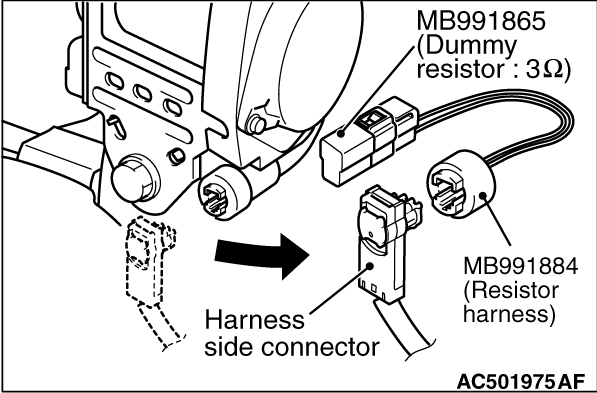|
|
Q.
Is diagnosis code B1519 set?
|
|
|
(1)Disconnect the negative battery terminal.
|

|
(2)Disconnect the connectors C-130 and then reconnect them.
(3)Connect the negative battery terminal.
(4)Erase the diagnosis code memory, and check the diagnosis code.
Q.
Is diagnosis code B1609 set?
 Go to Step 3. Go to Step 3.
 The procedure is complete. It is assumed that diagnosis code B1609 set as connector C-130 was engaged improperly. The procedure is complete. It is assumed that diagnosis code B1609 set as connector C-130 was engaged improperly.
|
|
|
(1)Disconnect the negative battery terminal.
|



|
(2)Disconnect connectors C-130, D-23 <LHD> or D-15 <RHD> and then reconnect them. For connector D-23 <LHD> or D-15 <RHD>, use a flat-tipped screwdriver to pull out the locking button at the harness side connector, and then disconnect the connector.
(3)Connect the negative battery terminal.
(4)Erase the diagnosis code memory, and check the diagnosis code.
Q.
Is diagnosis code B1609 set?
 Go to Step 4. Go to Step 4.
 The procedure is complete. It is assumed that diagnosis code B1609 set as connector C-130, D-23 <LHD> or D-15 <RHD> was engaged improperly. The procedure is complete. It is assumed that diagnosis code B1609 set as connector C-130, D-23 <LHD> or D-15 <RHD> was engaged improperly.
|
|
|
(1)Disconnect the negative battery terminal.
|


|
(2)Disconnect seat belt pre-tensioner (passenger’s side) connector D-23 <LHD> or D-15 <RHD>. Use a flat-tipped screwdriver to pull out the locking button at the harness side connector, and then disconnect the connector.
|

|
(3)Connect special tool dummy resistor (MB991865) to special tool resistor harness (MB991884).
(4)Connect special tool (MB991884) to the D-23 <LHD> or D-15 <RHD> harness side connector.
(5)Connect the negative battery terminal.
(6)Erase diagnosis code memory, and then check the diagnosis code.
Q.
Is diagnosis code B1609 set?
 Go to Step 5. Go to Step 5.
 Replace the seat belt with pre-tensioner (passenger’s side) (Refer to Replace the seat belt with pre-tensioner (passenger’s side) (Refer to  ). ).
|
|
|
(1)Disconnect the negative battery terminal.
|

|
(2)Disconnect SRS-ECU connector C-130.
|


|
(3)
| danger |
To prevents the seat belt pre-tensioner from operating unintentionally, disconnect the seat belt pre-tensioner (passenger’s side) connector D-23 <LHD> or D-15 <RHD> to short the squib circuit.
|
Disconnect seat belt pre-tensioner (passenger’s side) connector D-23 <LHD> or D-15 <RHD>. Use a flat-tipped screwdriver to pull out the locking button at the harness side connector, and then disconnect the connector.
|

|
(4)
| caution |
Insert an insulator such as a cable tie to a depth of 4 mm or more, otherwise the short spring will not be released.
|
Insert a cable tie [3 mm wide, 0.5 mm thick] between terminals 27, 28 and the short spring to release the short spring.
|

|
(5)
| caution |
Do not insert a test probe into the terminal from its front side directly as the connector contact pressure may be weakened.
|
Resistance measurement between C-130 harness side connector terminals 27 and 28.
OK: Open circuit.
Q.
Is the check result normal?
 Go to Step 6 . Go to Step 6 .
 Repair the harness wires between SRS-ECU connector C-130 (terminal No.27 and 28) and the seat belt pre-tensioner (passenger’s side) connector D-23 <LHD>/D-15 <RHD> (terminal No.2 and 1) Repair the harness wires between SRS-ECU connector C-130 (terminal No.27 and 28) and the seat belt pre-tensioner (passenger’s side) connector D-23 <LHD>/D-15 <RHD> (terminal No.2 and 1)
|
|
|
Q.
Is diagnosis code B1609 set?
|
|
|
 Replace the SRS-ECU (Refer to Replace the SRS-ECU (Refer to  ). ).
|
|
|
|
|
|
 An intermittent malfunction is suspected (Refer to GROUP 00, How to Cope with Intermittent Malfunction An intermittent malfunction is suspected (Refer to GROUP 00, How to Cope with Intermittent Malfunction  ). ).
|
|
|
|

 Go to Step 2.
Go to Step 2. Go to Step 3.
Go to Step 3.


 Go to Step 6 .
Go to Step 6 . Repair the harness wires between SRS-ECU connector C-130 (terminal No.27 and 28) and the seat belt pre-tensioner (passenger’s side) connector D-23 <LHD>/D-15 <RHD> (terminal No.2 and 1)
Repair the harness wires between SRS-ECU connector C-130 (terminal No.27 and 28) and the seat belt pre-tensioner (passenger’s side) connector D-23 <LHD>/D-15 <RHD> (terminal No.2 and 1) Replace the SRS-ECU (Refer to
Replace the SRS-ECU (Refer to  ).
). An intermittent malfunction is suspected (Refer to GROUP 00, How to Cope with Intermittent Malfunction
An intermittent malfunction is suspected (Refer to GROUP 00, How to Cope with Intermittent Malfunction  ).
).

